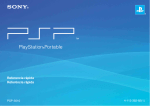Download Sony PSP-1004 User's Manual
Transcript
Quick Reference PSP-1004 7010187 GB Introduction Using the Home Menu GAME Playing games VIDEO Category Playing video MUSIC Playing music Item PHOTO Displaying images Busy icon: NETWORK Connecting to the Internet SETTINGS Adjusting PSP® system settings This icon is displayed when a page is loading. 1 Select a category using the left or right button. 2 Select an item using the up or down button. 3 Press the button to confirm the selected item. This document describes basic operations of the PSP® system. For detailed instructions, refer to the online user’s guide ( page 23). GB Directional buttons: button: Used to select categories/items POWER HOME button: Returns to the Home Menu Cancels selected operations HOLD HOME VOL SELECT button: START Confirms selected items button: Displays the options menu/control panel Select an icon, and then press the to display the options menu. Icons button Options menu While playing content, press the to display the control panel. button Control panel 01 Preparation Checking the package contents Check that you have all of the following items. If any items are missing, contact the appropriate PSP® customer service helpline which can be found within every PSP® format software manual. R POWE HOLD T STAR SELE 5V CT L VO HOME AC Adaptor PSP® (PlayStation®Portable) system Printed Materials Battery Pack Preparation Checking the package contents Supplied with the Value Pack only About the PSP® system documentation GB The PSP® system documentation includes the following: • Safety and Support Before using the product, carefully read this document first. It contains safety information related to the use of the PSP® system, troubleshooting, specifications and other information. • Quick Reference (this document) Headphones* with Remote Control This document contains information on basic hardware operations of the PSP® system. * Ear Friendly Headphones • User’s Guide Memory Stick Duo™ (32 MB) (access from : eu.playstation.com/manuals) This online document is accessed through the Internet and contains detailed information related to the use of the PSP® system software ( page 23). Pouch Wrist Strap Cloth 02 Preparation Preparing the PSP® system for use Charging the battery Before using the PSP® system for the first time after purchase, you must follow these steps to charge the battery. 1 Insert the Battery Pack. While holding down the PUSH button, slide the battery cover in the direction of the arrow. Align the bottom surface of the Battery Pack with the system to attach the battery. Caution UMD PUSH 1 P • The socket-outlet shall be installed near the equipment and shall be easily accessible. • Do not plug the AC Power Cord for the PSP® system into an electrical outlet until you have made all other connections. 2 Notice Do not use the PSP® system with the AC Adaptor when the Battery Pack is not inserted in the system. If the AC Adaptor is disconnected suddenly, it may result in damage to the system. Align the tabs, and then slide the cover in the direction of the arrow until it locks firmly into place. UMD PUSH 4 3 Preparation Preparing the PSP® system for use 2Attach the AC Adaptor to charge the battery. 1 POWER HOLD HOME VOL SELECT GB Initial setup Slide the POWER/HOLD switch up. POWER indicator START POW ER 1 SE LE CT STA RT HOL D POWER/HOLD switch The POWER indicator lights up in green, and the initial setup screen is displayed. 2Follow the on-screen instructions to make settings for system language, time zone, date and time and nickname. When you have completed initial setup, the Home Menu ( page 2) is displayed. The POWER indicator lights up in orange, indicating that charging has begun. The POWER indicator will turn off when the battery is fully charged. 2 To electrical outlet Hints •See “Using the on-screen keyboard” ( page 24) for information on entering characters. •Settings made during initial setup can be changed later in (Settings). See the user’s guide ( page 23) for details. 03 Preparation Part names and functions System OPEN latch (top) ( page 12) LCD screen L button R button Directional buttons button button button button Memory Stick Duo™ access indicator ( page 13) POWER indicator WLAN switch (left side) POWER HOLD WLAN access indicator HOME SELECT VOL START Lights up when using the wireless LAN feature Analog stick START button SELECT button HOME button Sound button Displays the Home Menu Volume + button switch (right side) ( page 10) ( ME HO page 10) POWER/HOLD HOLD indicator Strap holder Volume - button ( ( page 9) Display button ( page 9) page 10) Preparation Part names and functions Using the sound button Press and release Each time you press the button, the tone changes among HEAVY POPS JAZZ UNIQUE OFF. *1 Press for more than one second The sound is muted. *2 *1 : The tone can be changed only when using headphones. Also, the tone setting is temporarily set to “OFF” during gameplay. *2 : To clear muting, press the sound button again. You can also clear by pressing the volume + or volume - button on the system or on the Remote Control. Using the display button Press and release Each time you press the button, the display changes among three levels of screen brightness. *1 Press for more than one second The backlight turns off and the screen goes blank. *2 GB Headphones with Remote Control The headphones with Remote Control are supplied with the Value Pack and are also sold separately. HOME VOL 2 Headphones 1 Remote Control *1 : The highest level (level 4) can be selected only while the PSP® system is plugged in using the AC Adaptor. *2 : To turn the backlight back on, press any of the PSP® system buttons. 04 Basic operations Power and sleep mode functions Use the POWER/HOLD switch to turn the system on or off, or to put it into sleep or hold mode. POWER/HOLD switch A Turning the system on / Putting into sleep mode Slide up B Turning the system off Slide up and hold for more than three seconds C Locking the system buttons* Slide down *All operations using system buttons are locked. POWER indicator POW A ER SE LE CT STA RT HOL D B C Solid green Power on Solid orange Charging Flashing green Charge level is low Light off Power off/in sleep mode POWER/HOLD switch POWER indicator HOLD indicator 10 HOLD indicator Solid yellow In hold mode Basic operations Power and sleep mode functions Sleep mode GB If the PSP® system is switched to sleep mode, the software that is playing will be paused. When sleep mode is cleared, you can begin playback from the point where the system entered sleep mode. Hints •To clear sleep mode, slide the POWER/HOLD switch up again. During video or audio playback, you can press the u button of the Remote Control to clear sleep mode. •Some software may prevent the system from entering sleep mode. 11 05 Basic operations Playing content on UMD™ and Memory Stick Duo™ media 3Select the icon, and then press the UMD™ content 1Slide the OPEN latch to open the disc button. cover. 2 Insert a UMD™. The icon is displayed in the Home Menu. Do not touch the recorded surface. Playback begins. OPEN latch L OPEN R 12 Hints • Press the HOME button to quit a game. •To remove the UMD™, stop playback and then slide the OPEN latch to open the disc cover. Basic operations Playing content on UMD™ and Memory Stick Duo™ media Content on Memory Stick Duo™ media 3Select the icon, and then press the GB button. Warning Keep Memory Stick Duo™ media out of the reach of small children, as the media could be swallowed by accident. 1 Open the slot cover. 2Press the Memory Stick Duo™ media until fully inserted. The icon is displayed in the Home Menu. A list of contents that can be played is displayed. Front side Slot cover Hint To remove the Memory Stick Duo™ media, press the media once in the direction of the arrow. Notice When the Memory Stick Duo™ access indicator ( page 8) is lit, do not eject the Memory Stick Duo™ media, turn off the system, or put the system into sleep mode. Doing so may cause data loss or corruption. 13 06 Basic operations Checking the battery charge level Battery charge level There is plenty of power left. The battery is getting low. The battery has almost run out. No battery power remains. The POWER indicator flashes green. Recharge the battery. 14 Hints •If the POWER indicator flashes green, save game progress and recharge the battery. If the battery runs out before you save, game progress will be lost. •Depending on the usage conditions and environmental factors, the charge level display may vary from the actual charge level. •If the PSP® system is left unused after the battery runs out, the date and time settings may be reset. If this occurs, the date and time setting screen will be displayed the next time the system is turned on. 07 Basic operations Copying music/videos/images Copy music/video/image files to Memory Stick Duo™ media and play or view files on the PSP® system. Copy methods vary depending on the device and software in use as well as file type. The following instructions are based on the most common copying methods. Music/video/image source 1 To a PC GB 2 To a PSP® system Examples: USB cable Audio CD Mini-B (5-pin) type PC Digital video camera Digital still camera Hints •If using a USB cable, connect the cable to the PSP® system and the PC, select (USB Connection) under (Settings) and then press the button. •You can connect to a PC with an operating system that supports the USB mass storage class. •Instead of a USB cable, you can use a Memory Stick USB reader/writer (not included) or a PC with a Memory Stick™ slot. 15 Basic operations Copying music/videos/images Copying music files Example: Importing video from a digital video camera 1. Import 1. Import Use compatible software to import music tracks from an audio CD to a PC. Import video to a PC. 2. Copy Create a folder named “MUSIC” on Memory Stick Duo™ media using a PC, and then save music files in the folder. MUSIC Hint File formats that can be played include MP3, AAC, and ATRAC. 16 Copying video files Example: Importing music tracks from an audio CD Import methods vary depending on the device in use. For details, refer to the instructions supplied with the device. 2. Convert/Copy Use compatible software to convert the video to a file format that can be played on the PSP® system. Then, create a folder named “VIDEO” on the Memory Stick Duo™ media and save the video files in the folder. VIDEO Basic operations Copying music/videos/images Copying image files Example: Importing images from a digital still camera 1. Import Import images to a PC. Import methods vary depending on the device in use. For details, refer to the instructions supplied with the device. 2. Copy Create a folder named “PICTURE” on Memory Stick Duo™ media using a PC, and then save image files in the folder. Conversion software GB PC software such as the following*1 can be used to copy files. When you use the following software to copy files to Memory Stick Duo™ media, the necessary folders are created automatically. •Media Manager for PSP® (PlayStation®Portable) System*2 You can use this software to convert music, video and image files to the required formats. • SonicStage*2 PICTURE Hints •If using a digital still camera that supports Memory Stick Duo™ media, you can view images by inserting the media from the camera directly into the PSP® system. •You can view image files in formats such as JPEG (DCF 2.0/ Exif 2.21 compliant), TIFF and GIF. You can use this software to import music files from an audio CD to your PC. • Image Converter*3 You can use this software to convert video files to an MP4 format that can be played on the PSP® system. *1 All Sony products sold separately *2You must use this software to transfer music files in ATRAC format. Also, the device that the Memory Stick Duo™ media is connected to must be compatible with MagicGate™. *3Image Converter software version 1.5 or earlier is not compatible with the PSP® system. 17 08 Network Adjusting network settings Required items Warning Turn off the WLAN switch when in crowded places, such as in a crowded train. If a person nearby is using a pacemaker, it is possible that the radio waves could affect the pacemaker. Example of a network configuration Network equipment connections and setup methods vary depending on the equipment used. Connect to the network through an access point. Network device such as a DSL or cable modem Access point or wireless router PC 18 Internet line The following items are generally required to set up the system to connect to a network. • Subscription to an Internet service provider • A network device, such as a DSL or cable modem •A WLAN access point or a wireless broadband router •Settings for the access point (SSID, WEP key, WPA key, etc. as specified when the access point was configured) Hints •An access point is a device used to connect to a wireless network. •A wireless broadband router is a device that includes both router and access point functions. A router is required if you are connecting a PC and the PSP® system to one Internet line at the same time. •SSID, WEP and WPA keys are types of wireless network information. They may be required when connecting to an access point or a router. This information is generally set in the access point or router using a PC. For details, refer to the instructions supplied with the access point or router. Network Adjusting network settings Creating a new network connection You can adjust network settings to connect to an access point and save the network connection data on the system. Network settings may vary depending on the equipment in use and the network environment. The following instructions are based on the most common network configuration and may not apply to all installations. 4Select “Scan”, and then press the GB right button. 1Select (Network Settings) under (Settings) from the Home Menu, and then press the button. 2Select “Infrastructure Mode”, and then press the button. 3Select “New Connection”, and then press the button. Hint When using an access point that supports automatic setup, select “Automatic” and then follow the on-screen instructions to automatically complete the necessary settings. For information on access points that support automatic setup, contact the access point manufacturer. 19 Network Adjusting network settings 5Select the access point that you want to use, and then press the button. An SSID is a code or a name that is assigned to the access point. If you do not know which SSID to use or if the SSID is not displayed, contact the person who set up or maintains the access point. 6Confirm the SSID for the access point, and then press the right button. 7Select the security settings as necessary, and then press the right button. Security settings vary depending on the access point in use. To determine which settings to use, contact the person who set up or maintains the access point. 8Enter the encryption key, and then press the right button. The encryption key field will display an asterisk (*) for each character you enter. If you do not know the key, contact the person who set up or maintains the access point. 20 Network Adjusting network settings 9Select “Easy” or “Custom” and adjust settings as necessary. Easy Basic settings are set automatically. Custom You can manually enter detailed settings information. For information on settings, refer to the instructions supplied by the Internet service provider or with the network device. 11Check the setting list. GB The setting values you entered are displayed. Follow the on-screen instructions to complete your network settings. Hints •If the connection test fails, follow the on-screen instructions to check the settings. Network settings for the connection can be changed from the options menu. For additional information, refer to the instructions supplied with the access point or router, or contact your Internet service provider. •Depending on the access point in use, you may need the MAC address for your system when connecting to a network. You can find the MAC address under (Settings) (System Settings) “System Information”. •For additional information on network settings, refer to the online user’s guide ( page 23). If you select “Custom”, follow the on-screen instructions and adjust settings as necessary. 10Check the connection name, and then press the right button. You can revise the connection name to use any name you like. 21 09 Network Connecting to the Internet 4Using the on-screen keyboard ( Using the Internet browser 1Check that you have access to a wireless network. 2Select (Internet Browser) under (Network) from the Home Menu, and then press the button. page 24), enter the address for the Web page. After you have entered the address, the PSP® system will connect to the Internet. While the page is loading, the busy icon is displayed in the lower right corner of the screen. When a connection is successfully established, the Web page will be displayed. The Internet browser starts. 3Using the up button, select the address bar, and then press the button. The on-screen keyboard is displayed. Address bar Busy icon Basic operations of the Internet browser Menu bar 22 Network Connecting to the Internet button + analog stick Scroll in any direction button + directional button Scroll by screen L button Go back to the previous page button Switch between displaying or not displaying the menu bar* *From the menu bar, you can access various features and settings such as “Back” and “Close Page”. Viewing the user’s guide GB You can use the Internet browser to view the online user’s guide for the PSP® (PlayStation®Portable) system. 1From the Home Menu, select (Online Instruction Manuals) under (Network), and then press the button. The user’s guide page is displayed. Hints •If you try to open a Web page using the Internet browser when a connection to the Internet has not been established, the system will automatically try to connect to the Internet. •With the default setting, the most recently used connection will be automatically selected when connecting to the Internet. PSP® system software user’s guide access from : eu.playstation.com/manuals The guide can also be viewed using your PC’s Web browser. 23 10 Keyboard Using the on-screen keyboard Control panel item list Cursor Text entry field Function keys (displays characters as they are entered) Keyboard keys Function Enters a space When entering text in the Internet browser address field, previously entered addresses are displayed. Addresses are displayed only when input mode is set to Web address shortcuts. Confirms characters that have been typed but not entered, and exits the keyboard Cancels characters that have been typed but not entered, and exits the keyboard Moves the cursor Alphabet/symbol keys Input mode display Text entry options Deletes the character to the left of the cursor Displays a diagram showing the system buttons and their usage Switches between upper and lower case Enters a line break 24 Keyboard Using the on-screen keyboard Switching input mode Entering characters The number of input modes available varies depending on the language selected. Each time you press the SELECT button, the input mode changes among the options in the diagram below: Input mode display Input mode Examples of characters you can enter Letters and numbers abcde Letters and numbers (with) accented letters) éíóçñ Numbers only 12345 Web address shortcuts .com .ne .html .gif Hint The language for the on-screen keyboard is linked to the System Language. For example, if “System Language” is set to “Français” under (Settings) (System Settings), the French keyboard is displayed. GB This section will demonstrate how to enter text using the word “FUN” as an example. 1Select “DEF3”, and then press the button several times until “F” is displayed. Each time you press the button, the character that is entered in the text entry field is switched. 2Select “TUV8”, and then press the button several times until “U” is displayed. 3Select “MNO6”, and then press the button several times until “N” is displayed. 4Select “Enter”, and then press the button. The characters you entered will be confi rmed. Select “Enter” again, and then press the button to exit the keyboard. Hint If you select the a/A key while entering characters, you can switch between upper and lower case. 25 11 PSP® system updates Updating the system software Software updates may include security patches, new or revised settings and features, and other items, which will change your current operating system. It is recommended that you always maintain your system to use the latest version of the system software. 1 Obtain update data. 2 Use the update data to overwrite the existing system software. 3T he system software is updated. Notice During an update: • Do not remove the UMD™. • Do not turn off the system. • Do not disconnect the AC Adaptor. If an update is cancelled before completion, the system software may become damaged, and the system may require servicing or exchange. 26 Hints •For the latest information on updates, visit eu.playstation.com/psp •Depending on the software title, you may not be able to play without first updating the PSP® system software. •After you have updated the system software, you cannot go back to an earlier version. •Before starting, check that the battery is charged. You may not be able to start an update if the battery charge level is low. PSP® system updates Updating the system software Update methods You can perform an update in any of the following ways. For detailed instructions, visit eu.playstation.com/psp 2Insert a UMD™ that contains update data. GB The update data icon and version number are displayed under (Game) in the Home Menu. With an Internet connection Network Update Update using the PSP® system’s wireless LAN feature. By selecting (Network Update) under (Settings), you can connect to the Internet and update your system to the latest system software. Update using a PC Update using a PC to download update data from the Internet. Without an Internet connection Update using a UMD™ You can update using a UMD™ that contains update data. 1Connect the AC Adaptor to the PSP® system. 3Select the (PSP™ Update), and then press button. The update begins. Follow the on-screen instructions to complete the update. Checking the system software version You can check system software version information by selecting (Settings) (System Settings) “System Information”. The current version is displayed in the System Software field. 27 12 Security Settings Setting the parental control level About parental control levels Parental control levels on the PSP® system The parental control level of the system can be either turned off or set to one of 11 different levels. Off Turns off parental control 11-1 Sets the level of content to be restricted. A setting of “1” is the most restrictive; “11” is the least restrictive. Parental control levels on content Parental control levels on the system The PSP® system includes a parental control feature. You can use this feature to set a password and limit the playback of content restricted by a parental control level (games, videos and other content). By setting the parental control level on the system, you can prevent the playback of restricted content by children. The default setting for the menu item is “9”. The combination of the parental control levels of both the PSP® system and the content determine whether the content can be viewed. The combination of the two levels is displayed in the table at right. 28 Example: If the parental control level of the system is set to “9”, content with a level from “1” to “9” can be played on the system. : Content can be viewed. : Content cannot be viewed. For further information about Parental Control Levels and corresponding age groups, visit eu.playstation.com/psp or refer to software manual. Security Settings Setting the parental control level Setting the parental control level GB 1Select (Security Settings) under (Settings), and then press the button. 2Select “Parental Control Level”, and then press the button. The password entry screen is displayed. 3Using the directional buttons, enter the 4-digit password, and then press the button. When entering a password for the first time after purchase, enter “0000”. 4Select a level, and then press the button. The parental control level is set. Hint To change the password, select “Change Password” under (Settings) (Security Settings). 29 “ ”, “PlayStation”, “ ” and “ ” are registered trademarks, and “UMD” is a trademark of Sony Computer Entertainment Inc. “SONY” and “ ” are registered trademarks of Sony Corporation. Also “Memory Stick”, “Memory Stick Duo”, “ ”, “SonicStage”, “MagicGate” and “ATRAC” are trademarks of the same company. eu.playstation.com/psp Images shown in this document may vary from the images on your PSP® system, depending on the system software version in use. © 2006 Sony Computer Entertainment Inc. All rights reserved.









































